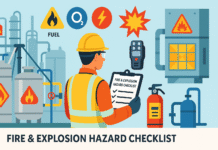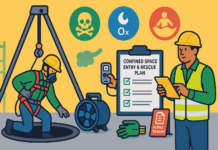
Fault Tree Analysis FTA
1. Introduction to Fault Tree Analysis (FTA)
In today’s complex industrial environments, system failures can be catastrophic. From aviation accidents to oil rig explosions and nuclear plant breakdowns, understanding failure causes is vital.
Fault Tree Analysis (FTA) is a structured, top-down risk assessment tool used to identify potential failure paths and prevent accidents before they happen.
In simple terms: FTA starts with the problem (top event) and works backward to find every possible cause.
2. What is Fault Tree Analysis?
Fault Tree Analysis (FTA) is a graphical, logic-based technique used to identify, analyze, and prevent failures.
- Developed in 1962 by Bell Labs for the U.S. Air Force
- Applied in aviation, oil & gas, manufacturing, nuclear, and automotive
- Helps find root causes, failure probabilities, and preventive measures
3. Purpose of FTA in Safety and Risk Management
3.1 Why Use FTA
- Identify hazards before accidents occur
- Quantify system failure probabilities
- Comply with OSHA, ISO 31000, IEC 61025
- Strengthen emergency preparedness plans
3.2 Where FTA is Applied
- Oil & Gas → Preventing refinery fires
- Aviation → Avoiding engine failures
- Nuclear Energy → Managing meltdown risks
- Manufacturing → Preventing production downtime
- Automotive → Avoiding brake system failures
4. Key Concepts & Terminologies in FTA
| Term | Definition | Example |
|---|---|---|
| Top Event | The main failure under study | Aircraft engine shutdown |
| Basic Event | Root cause of a fault | Sensor malfunction |
| Intermediate Event | Result of combined failures | Loss of oil pressure + overheating |
| Logic Gates | Show relationships between causes | AND, OR, NOT gates |
| Cut Sets | Failure combinations causing top events | Pump failure + valve stuck |
| Minimal Cut Set | Smallest possible cause combo | Short circuit + loose wiring |
5. Fault Tree Analysis Symbols
| Symbol | Type | Meaning |
|---|---|---|
| ⬜ Rectangle | Event | System failure |
| ⚪ Circle | Basic Event | Root cause |
| 🔻 Triangle | Transfer Symbol | Continuation of tree |
| ⩓ | AND Gate | Failure occurs if all inputs fail |
| ≥1 | OR Gate | Failure occurs if any input fails |
6. How Fault Tree Analysis Works (Step-by-Step)
Step 1 – Define the Top Event
Example: “Explosion in Gas Processing Unit.”
Step 2 – Understand the System
- Review equipment manuals & process diagrams
- Analyze past incident reports
- Consult subject matter experts
Step 3 – Identify Failure Modes
Break the system into subsystems and map possible faults, e.g.:
- Gas leaks due to corroded pipes
- Ignition from faulty wiring
- Operator error during valve operation
Step 4 – Use Logic Gates
AND Gate Example
Explosion occurs only if:
- Gas leak AND
- Ignition source are both present
OR Gate Example
Explosion occurs if any of these happen:
- Pressure relief valve stuck
- Gas detector fails
- Operator ignores warning alarm
Step 5 – Quantify Probabilities
Use failure rate data and reliability formulas:
For AND Gates
P(Top Event) = P1 × P2
(All inputs must fail together)
For OR Gates
P(Top Event) = P1 + P2 - (P1 × P2)
(Failure occurs if any input fails)
Step 6 – Mitigate Risks
Once high-risk failure paths are identified:
- Replace faulty components
- Improve maintenance schedules
- Train operators on emergency response
7. Types of Fault Tree Analysis
| Type | Description | Example Use |
|---|---|---|
| Qualitative FTA | Identifies failure paths without numbers | Small equipment |
| Quantitative FTA | Calculates probabilities for each path | Nuclear plant |
| Dynamic FTA | Considers time-sensitive dependencies | Process safety |
8. Advantages of FTA
- Identifies hidden failure paths
- Visual representation improves communication
- Allows risk prioritization
- Supports compliance with international safety standards
9. Limitations of FTA
- Time-consuming for large systems
- Needs highly accurate data
- Can become complex for interdependent failures
10. Real-World Examples of FTA
Case 1: Piper Alpha Oil Rig Explosion (1988)
- Cause: Gas leak + pump failure
- Impact: 167 deaths
- FTA Role: Revealed undetected failure paths
Case 2: Boeing 737 MAX Crashes (2018-19)
- Cause: Sensor + software malfunction
- FTA Role: Used to redesign MCAS safety controls
Case 3: Fukushima Nuclear Disaster (2011)
- Cause: Tsunami flooding backup power
- FTA Role: Triggered global nuclear safety upgrades
11. FTA vs. FMEA vs. HAZOP
| Aspect | FTA | FMEA | HAZOP |
|---|---|---|---|
| Approach | Top-down | Bottom-up | Brainstorming |
| Focus | Failure combinations | Individual failures | Hazard analysis |
| Output | Fault tree diagram | Failure tables | Hazard logs |
| Best Use | Complex systems | Component-level reliability | Chemical processes |
12. Software Tools for FTA
- CAFTA → Best for nuclear industries
- FaultTree+ → Excellent for quantitative analysis
- OpenFTA → Free and open-source
- Reliability Workbench → Integrates FTA + FMEA
13. Best Practices for FTA
- Always use updated system data
- Combine FTA with FMEA & HAZOP
- Regularly update after modifications
- Use software for accurate probability calculations
14. External Resources
15. Conclusion
Fault Tree Analysis (FTA) is an essential tool for risk assessment and accident prevention. By mapping potential failure paths, calculating probabilities, and improving control measures, organizations can save lives, reduce costs, and ensure compliance.
In high-risk industries, FTA isn’t optional — it’s necessary.
FMEA (Failure Modes & Effects Analysis)
Hierarchy of Controls in Risk Assessment
Designing a 3×3 vs 5×5 Risk Matrix
Gas Cylinder Handling JSA – Job Safety Analysis
16. FAQs
Q1. What industries use FTA the most?
Aviation, oil & gas, automotive, nuclear, and manufacturing.
Q2. Is FTA qualitative or quantitative?
It can be both — qualitative for pathways, quantitative for probabilities.
Q3. Is FTA mandatory for OSHA compliance?
Not directly, but it supports risk assessment requirements.
Q4. What is the main difference between FTA and FMEA?
FTA is top-down, FMEA is bottom-up.
Q5. Can I do FTA manually without software?
Yes, but software like OpenFTA and FaultTree+ make it easier and faster.
























